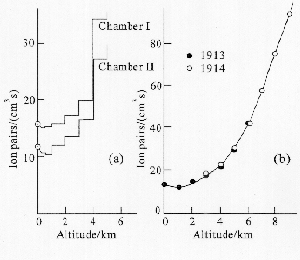
Figure 1 Variation of ionization with altitude (a) Hess (1912); (b) Kolhörster (1913, 1914) [1-2].
Fizikai Szemle honlap |
Tartalomjegyzék |
ARNOLD WOLFENDALE
Introduction
The end of the last century saw many studies of the properties of ionizing radiations and the names of the most important practitioners, such as Becquerel, the Curie's and Röntgen are now part of the language of science.
One problem, that survived the dawn of the new century, was the reason for the decay of charge on the electroscopes even when no obvious radiation was present. One idea was that there was some form of super gamma-radiation coming from unknown sources in the earth and a number of experiments were mounted on high towers to check the hypothesis.. No clue for the origin of this "new" radiation appeared, however, and it was natural that balloon-borne equipment should be pressed into service. A number of comparatively low level flights followed but it was not until an ardent and skilful balloonist, Viktor Hess, achieved sufficient height ( 17,500 ft) and with a superior electroscope that success was achieved. A series of three flights, in 1912, [ 1 ] gave consistent results - for the strength of the radiation: the intensity fell slightly and was then roughly constant to a height of 2 km but if more than doubled by a height of nearly 5 km. Hess then made his famous claim:
"The results of the present observations seem to be most readily explained by the assumption that a radiation of very high penetrating power enters our atmosphere from above, and still produces in the lowest layers a part of the ionisation observed in closed vessels."
In the next the next two years he went even higher and reached 9 km, where the increase was a factor of about 7. Kolhorster [2] in 1913 and 1914 went higher still, with similar results (Figure 1). Nowadays his conclusion is an obvious one but not so then when not only were detectors in a far-from-perfect state but atmospheric phenomena could well have been responsible. Indeed, had the presence of the ionosphere been known at that time, it is very likely that Hess's conclusions would have been very different.
It seems that it was Millikan, of "charge-on-the-electron" fame, who coined the term "Cosmic Radiation" to describe the incoming entities. In fact, it was an unfortunate title because the vast majority of the incoming "radiation" turns out to be nuclear particles (including electrons and the elusive neutrinos).
Later work has identified
a great range of nuclear charges in the beam, at least at "low"
eneraies, where direct measurements can be made.
Measurements in the 1930's
and 1940's - using nuclear emulsions and cloud chambers - led
to the discovery of many important fundamental particles, amongst
them the pion, muon, positron and the "strange particles".
With the advent of accelerators in the 1950's the field of elementary
particle physics has largely been the province of the accelerator
physicist although there have been advances, from time to time,
from studies using cosmic rays - at energy above those available
at the big machines [3] and measurements on neutrinos.

Figure 1
Variation of ionization with altitude (a) Hess (1912); (b) Kolhörster
(1913, 1914) [1-2].
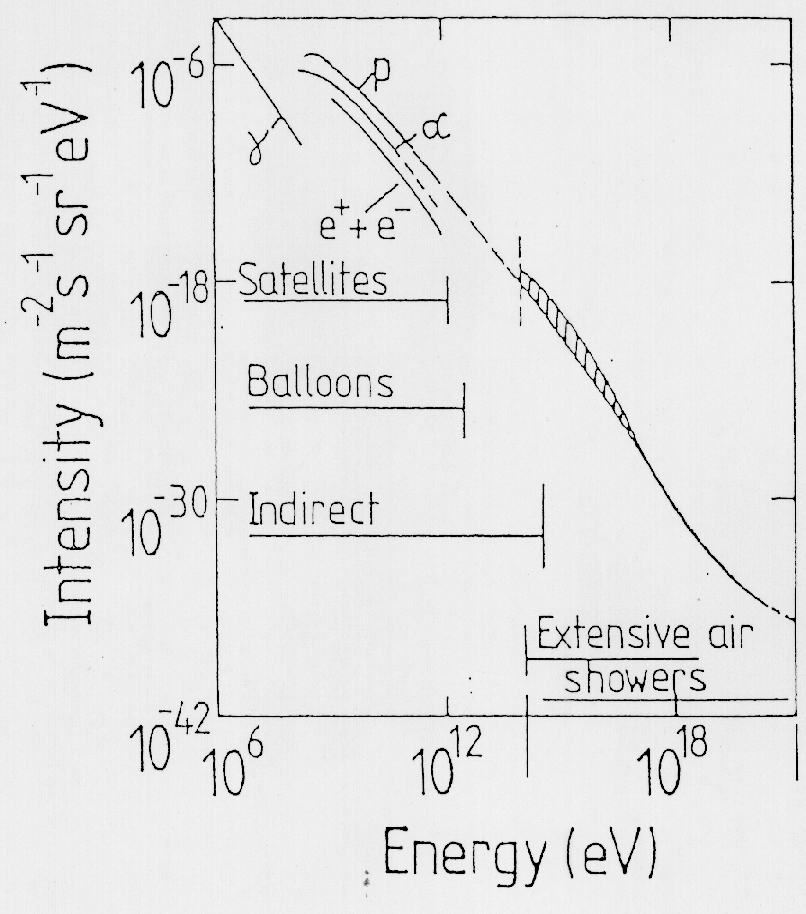
Figure 2
Cosmic ray energy spectra. The intensity is uncertain in the
shaded area - although Erlykin and I think we know what it is!
The methods of study are indicated.
The subject has, nevertheless, advanced considerably in the area of Astrophysics and, to a much lesser extent, in the field of Geophysics. In Astrophysics there are the two aspects: the use of astronomical phenomena to shed light on the problem of cosmic ray origin and the reverse, the use of cosmic ray results to illuminate astronomical problems. Both will be considered here.
The Origin Problem
Most cosmic rays are energetic
protons (we discount neutrinos, from here on , although neutrino
astronomy is a coming science). Having an electrical charge they
are deflected by the magnetic fields encountered between source
and detection on earth. Moving out from the earth, the magnetic
fields are those associated with the earth, the interplanetary
medium and the interstellar medium (ISM). If, as is very likely,
the most energetic particles of all are of Extragalactic origin,
then the list must include the field in the intergalactic medium
(IGM). Of these fields, only the first mentioned is known with
any precision. Digressing for a moment into the domain of "energy",
cosmic rays start, conventionally, at the rest mass of the particle
(~ 109 eV for protons) and continue up, with diminishing
intensity, to a present record high energy of 3 x 1020
eV (the Fly's Eye experiment) [4]. Those above about 1011
eV are not affected by the field in the interplanetary medium
- but there is then a vast expanse of energy - to  1018 eV - where the field in the ISM dominates, if
the primaries are still mainly protons. The expanse extends to
higher energies still, if the nuclei are more massive (e.g. times
26 for iron primaries). Figure 2 gives the cosmic ray energy spectrum
at earth for some of the major components.
1018 eV - where the field in the ISM dominates, if
the primaries are still mainly protons. The expanse extends to
higher energies still, if the nuclei are more massive (e.g. times
26 for iron primaries). Figure 2 gives the cosmic ray energy spectrum
at earth for some of the major components.
Only at the very lowest energies ( < 1010 eV) do cosmic rays occasionally arrive from the sun, largely via the giant solar flares. Thus, one is immediately into the problem of the magnetic field in the ISM. Alas, its topography is not known in any detail at all so that "ray-tracing", from detector back to source, is impossible, (the situation for that tiny fraction of the cosmic ray flux above 1018 eV will be considered later). Other arguments are necessary.
Before continuing, we can identify two (extreme) possibilities for cosmic ray origin - that they are Galactic or that they are Extragalactic.
Energy Densities
It is instructive in all astrophysical
systems, and, indeed, elsewhere, to consider the energy density
of the phenomenon under study in comparison with those of possibly
related phenomena. Table 1 gives such a comparison. Considering
the Galactic energy densities, it looks as though there might
be a case for concluding that "cosmic rays are Galactic",
although it is rather off-putting that apparently disparate phenomena,
such as stellar radiation and gas motion, have the same energy
density as that in cosmic rays. For the Galactic magnetic field,
however, a plausible connection with cosmic rays can be made,
although this might be more to do with trapping than with origin
itself. The argument here is that the cosmic ray pressure builds
up until it is equal to that in the magnetic field and then the
field "expands" to allow some particles to leak out
into extragalactic space.

Figure 3
Gamma ray fluxes (of energy above 100 MeV) from the GRO satellite
in comparison with what would be expected if the cosmic ray intensity
were the same there as locally (denoted EG) [9,10]. The observed
fluxes are much smaller than expected, indicating that most of
the local cosmic rays come from our own Galaxy. (The estimated
"source" contributions are indicated).
This argument with respect to a Galactic origin breaks down when it is realised that the energy density of the cosmic microwave background (CMB) - which is certainly of Extragalactic origin - is the same as that in cosmic rays, to within a factor 2 (it is 0.24 eV cm-3). Bearing in mind that most of the cosmic rays (and the associated energy density) are below about 1010 eV - and well below the energy where interactions between cosmic rays (protons) and the CMB start to become important (~ 2.1018 eV) - an Extragalactic origin for cosmic ray protons cannot be ruled out. It is true (see, for example, [5]) that although the energy content in cosmic rays in the Universe as a whole would be high, it would not be impossibly so; it is also true that there are potential sources in Extragalactic space [5].
Another approach must be made.
Gamma Ray Astronomy
Are Cosmic Rays Galactic or Extragalactic?
Although the bulk of cosmic rays are particles, about 10-6 of the flux is composed of gamma rays. Insofar as many of the gamma rays are produced by the interactions of cosmic rays with the ISM, and they travel in straight lines, they provide proxy indicators of cosmic ray intensities in other parts of the Galaxy and beyond. Several approaches have been made, and these lead to the conclusion that particles of Galactic origin predominate.
The first, historically [6] and later papers, see also [7] for a summary, was the demonstration of a "Galactic gradient", i.e. a fall-off of cosmic ray intensity with distance from the centre of the Galaxy. Although subject to considerable argument initially, it is now accepted that there is such a gradient, indicating that the sources of most cosmic rays are in our own Galaxy and there are more and more as one approaches the Galactic Centre. An interesting - and important - by-product of the early work was the demonstration that the mass of molecular hydrogen in the ISM had been over-estimated [8] by those whose measured carbon monoxide line intensities had been used, via an empirical constant, to estimate the column density of H2. This "discovery" is a good example of the use of cosmic rays to help the astronomers.
Confirmation of the fact that most of the cosmic rays in the Galaxy are actually produced here has come from the detection of gamma rays from the Magellanic Clouds (MC). The argument is a simple one. If cosmic rays were Extragalactic, specifically, if they were Universal, - i.e. filled the Universe at roughly the same intensity - then the intensity within the MC would be the same as that locally. Since the mass of target gas in the MC is known reasonably well, the expected flux of gamma rays can be calculated. Comparison with observation then enables the question of universality, or otherwise, to be answered. Whilst it is true that, as usual, there are subtleties, in this case largely to do with the contribution to the gamma ray flux from unresolved discrete sources, the conclusion is quite robust. It is (Figure 3) that the observed fluxes from both Magellanic Clouds, Large and Small, are much smaller than would be the case for a cosmic ray intensity there being the same as that locally [9,10]. It is concluded that less than 10% of cosmic rays at earth come from Extragalactic sources. In fact, the fraction is very probably considerably less than 10%. It must remember, however, that the figure given above relates to the total intensity and most of this is in low energy particles (Figure 2). At high energies, say above 1018 eV, it could well be that most of the particles come from beyond the Galaxy. This topic will be taken up in more detail, later.
The question now, is, just what are the Galactic objects, or systems, responsible for the "low" energy particles? There are a number of possibilities, but supernova remnants (SNR) are the front-runners. The idea, which has been worked out in many publications [11,12], is that the SNR shocks, passing through the ISM, accelerate up the "seed" cosmic rays to high energies. In a standard calculation [12], the energy spectrum generated is roughly of the form N(E) = A E-2 where E is the (relativistic) energy, and the maximum energy is given by;

where ESN is the
SN energy, M the released mass, No the gas density
and Bo the magnetic field.
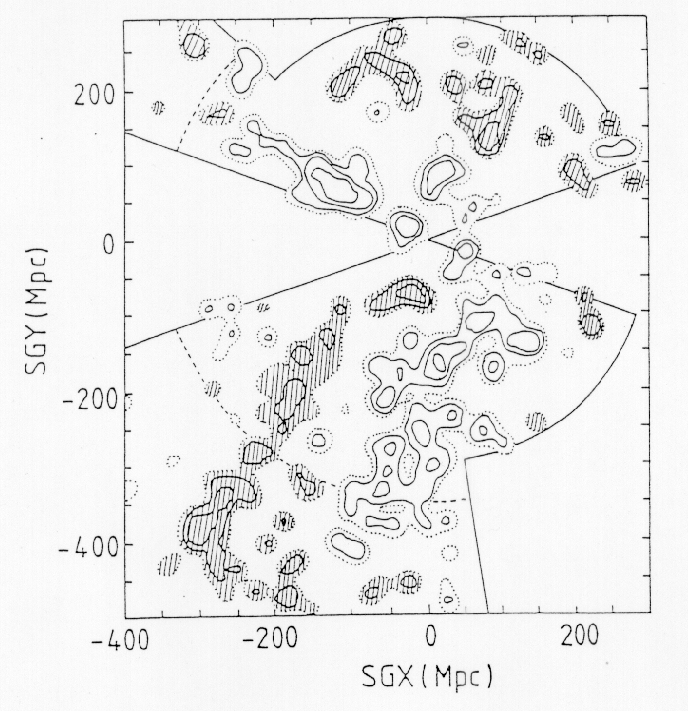
Figure 4
Map of the nearby Universe with marked typical divisions into
Superclusters and anti-Superclusters [13]. Our analysis shows
that such divisions cannot exist - on any scale - there would
be too big a flux of extragalactic gamma rays. Thus, the contemporary
Universe must be overwhelmingly of matter, and not anti-matter.
We are at the centre (0,0) on the edge of the local (VIRGO) supercluster.
Since the most favourable values for all the parameters in brackets is ~ 1, (and this if for the "hot" ISM) it is seen that the maximum for iron nuclei, the most likely "massive" contributor to cosmic rays (for good astrophysical reasons), is a little over 1016 eV. A. D. Erlykin and I claim to have discovered a feature in the cosmic ray spectrum which can be attributed to iron nuclei of this order of energy (and other nuclei, too), and the very recent results from our work will be described shortly.
Irrespective of the Erlykin and Wolfendale (EW) work, most cosmic ray workers would agree with the argument that SNR are powerful contributors to the general cosmic ray flux - at least to 1015 eV, or so. At higher energies there is, alarmingly, a dearth of good origin theories.
Before delving into the EW results, an analysis will be described of another, powerful, application of the cosmic gamma ray technique - the search for anti-matter.
Gamma Rays and the Anti-Matter Problem
Physics has many "Conservation
Laws" - such as the Conservation of Energy, Momentum, Charge
and so-on. With the advent of anti-matter, predicted from the
work of Dirac, and particularly apparent in the case of electrons
(e-) and the associated positrons (e+),
it was natural to expect that matter (M) and anti-matter  were conserved in the sense that for every unit of matter created
there was an equal amount of anti-matter. If, as would be expected,
equal amounts of M and
were conserved in the sense that for every unit of matter created
there was an equal amount of anti-matter. If, as would be expected,
equal amounts of M and  were created in
the very Early Universe then we have the big question: "where
has all the anti-matter gone?".
were created in
the very Early Universe then we have the big question: "where
has all the anti-matter gone?".
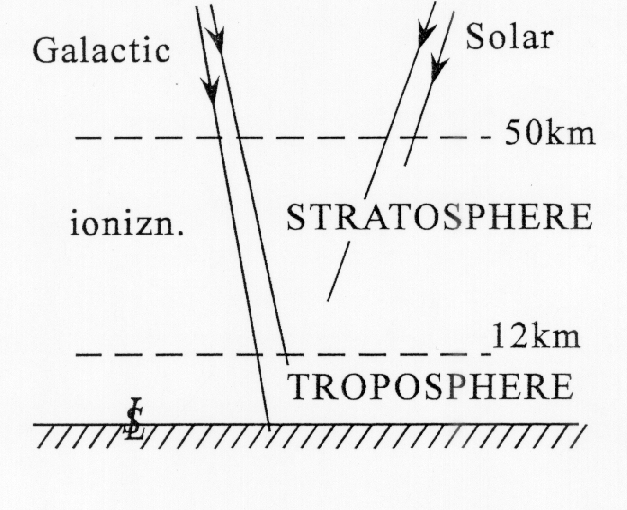
Figure 5
The ionization produced by Galactic cosmic rays, and solar flare
particles, which might have an effect on the climate.
We know from rather direct
arguments that there can be no question of there being matter-anti-matter
symmetry in the solar system (Neil Armstrong's words when he stepped
on the moon - were not his last words: "one small
step for man, 1030 pi-mesons for mankind"!). Many
studies have shown that the gamma rays resulting from M  annihilation would have been of too high a flux to be compatible
with observation if there were symmetry on any scale out to that
of galaxy clusters. However, there is (or, rather, was) the possibility
that on the very largest scales in the Universe - that of superclusters
- there was such symmetry. The idea is that in the very early
universe, perhaps, cells of M and
annihilation would have been of too high a flux to be compatible
with observation if there were symmetry on any scale out to that
of galaxy clusters. However, there is (or, rather, was) the possibility
that on the very largest scales in the Universe - that of superclusters
- there was such symmetry. The idea is that in the very early
universe, perhaps, cells of M and  were
created which rapidly separated. We, ourselves - by definition
- reside in a matter-supercluster.
were
created which rapidly separated. We, ourselves - by definition
- reside in a matter-supercluster.
Dr. Dudarewicz and I [ 13]
looked at this topic in some detail, using the latest cosmic gamma
ray and astronomical data, and we concluded that there would be
an overlap of the hot gas, and  escaping
from the Superclusters (S) and anti-superclusters (
escaping
from the Superclusters (S) and anti-superclusters (  ) such as to still give too many gamma rays
(see Figure 4). Another
interesting feature was the fact that occasionally an individual
galaxy (or galaxy ) would venture into the opposite regime. Again,
too many gamma rays would be produced. Figure 4 shows the results.
) such as to still give too many gamma rays
(see Figure 4). Another
interesting feature was the fact that occasionally an individual
galaxy (or galaxy ) would venture into the opposite regime. Again,
too many gamma rays would be produced. Figure 4 shows the results.
Thus, there is no M  symmetry on any scale. Just how the
symmetry on any scale. Just how the  disappeared
soon after the Big Bang is still not completely clear.
disappeared
soon after the Big Bang is still not completely clear.
Cosmic Rays and Life on Earth
The "Normal Situation"
As a source of the radiation "background" to which humans are subjected, cosmic rays are not negligible, about 30% of the natural background being due to this cause (near ground level and in "average" locations). The rest is due to the radioactive emanations from naturally occurring materials.
However, cosmic rays may
also have relevance to another phenomenon which affects the
human condition: the climate. The situation relates to the apparent
"effect of sunspots on the weather". In fact, there
can be no direct effect because the energy changes in solar irradiation
associated with the 11-year solar cycle are quite negligible.
That is not to say that individual wavelength regions do not vary
much the reverse is true: the UV flux, for example, changes considerably
(by about 30% over the 11-year cycle). However, the energy in
this component is absorbed in the upper levels of the atmosphere,
and there has been the traditional view that there is very little
interchange between the upper levels and the lower region (troposphere)
where "the weather" resides. Help may now be at hand
with the claim (which looks quite well-founded) that the link
between the solar variability and the troposphere may be via cosmic
rays. The argument runs as follows. Cosmic rays produce ionization
of the air as they pass through and ionization is relevant to
cloud-forming ability. The cosmic rays of concern are mainly of
Galactic origin (from supernovae see later) and their intensity
is modulated considerably by the solar wind over the 11year cycle).
The evidence so far is a correlation [ 14] between the cloud cover
over the oceans and the cosmic ray intensity. There is also a
claim that the ozone density in Polar regions is affect by low
energy solar protons, the intensity of which varies, again, during
the solar cycle [15]. It is true that there is argument as to
whether the ionization effect is large enough to cause the observed
effects - cloud cover and ozone depletion - but, at least, it
gives a starting point for more detailed analysis.
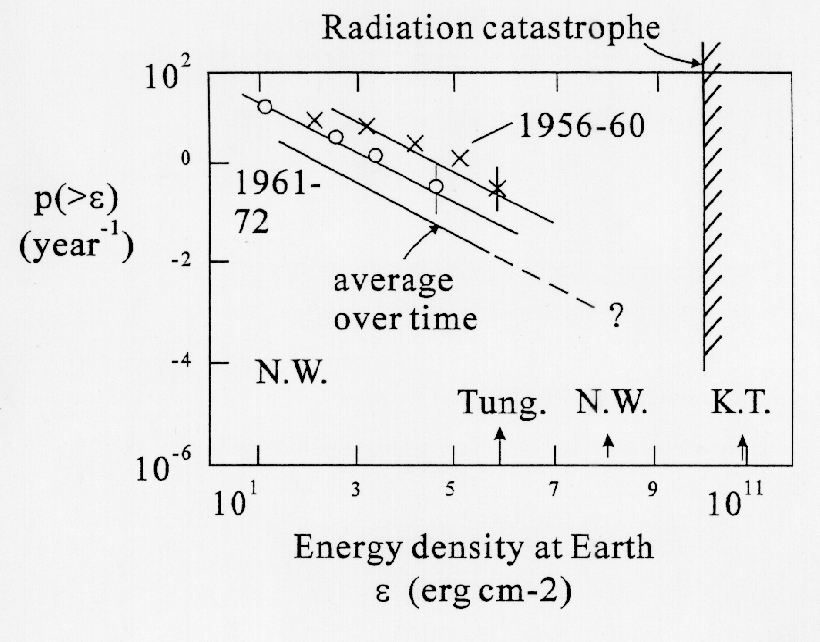
Figure 6
Cosmic rays associated with solar flares [ 16]. P ( > ) denotes the frequency, per year, of energetic solar flares which
deposit more than energy
) denotes the frequency, per year, of energetic solar flares which
deposit more than energy  at the earth.
The points come from observations on solar flares for the periods
indicated. "Average over time" relates to the average
over many decades and, specifically, for the energy deposited
on the earth.
at the earth.
The points come from observations on solar flares for the periods
indicated. "Average over time" relates to the average
over many decades and, specifically, for the energy deposited
on the earth.
Tung, N.W. and K.T. denote
energy densities associated with the Tunguska bolide, the "Nuclear
Winter" (an E-W exchange of 10,000 Megatons each) and the
(possible) bolide which arrived 65 My ago at the K.T. geological
boundary.
It is also true that the effect on long term climate, as distinct from local weather, remains to be established; however, the stakes are so high in this field that serious study is essential.
Rare Solar Phenomena
It is not outside the realms of possibility that very rare solar flares, and associated cosmic ray particles, may have a significant effect on "life on earth". Figure 6 shows the frequency distribution for the energy delivered to earth by cosmic ray flares [16]. Measurements have been made for only 50 years or so and extrapolations are clearly dangerous but it would not be at all surprising if every few hundred thousand years or so, there were quite damaging flare effects. The fact that we are here at all means that really catastrophic flares have not occurred but that does not mean that serious effects have been absent nor does it mean that serious effects will not occur in the future. Although some work has been done on this topic it would repay further study.
Fine Structure in the Cosmic Ray Spectrum
The Problem
So far, the evidence favouring cosmic ray production in supernova remnants (SNR) has been circumstantial. What, then, would be a distinctive signature? At very low energies (E < 1010 eV) there is the gamma ray work which shows a small excess of cosmic ray intensity within the Loop I SNR [ 17] although the reason for the excess is not completely secure. If it could be shown that there is a signal consistent with the theoretical predictions (see earlier) of a sharp cut off at an energy in the region of 4.1015 Z eV then the case for SNR region would be strengthened considerably.
The EW Analysis
Tolya Erlykin and I have made
such a claim [18] from a detailed study of extensive air showers
(EAS). Such showers were discovered in 1937 by Auger and Maze
and their associates [ 19] and are due to the impact on the atmosphere
of very energetic particles. Figure 7 shows the situation. It
is the generation of such showers, with their wide lateral spread
(many hundreds of metres) that enables the extraordinarily rare
high energy particles to be detected at all. Paradoxically, to
be deep in the atmosphere is better for detection than at great
heights!
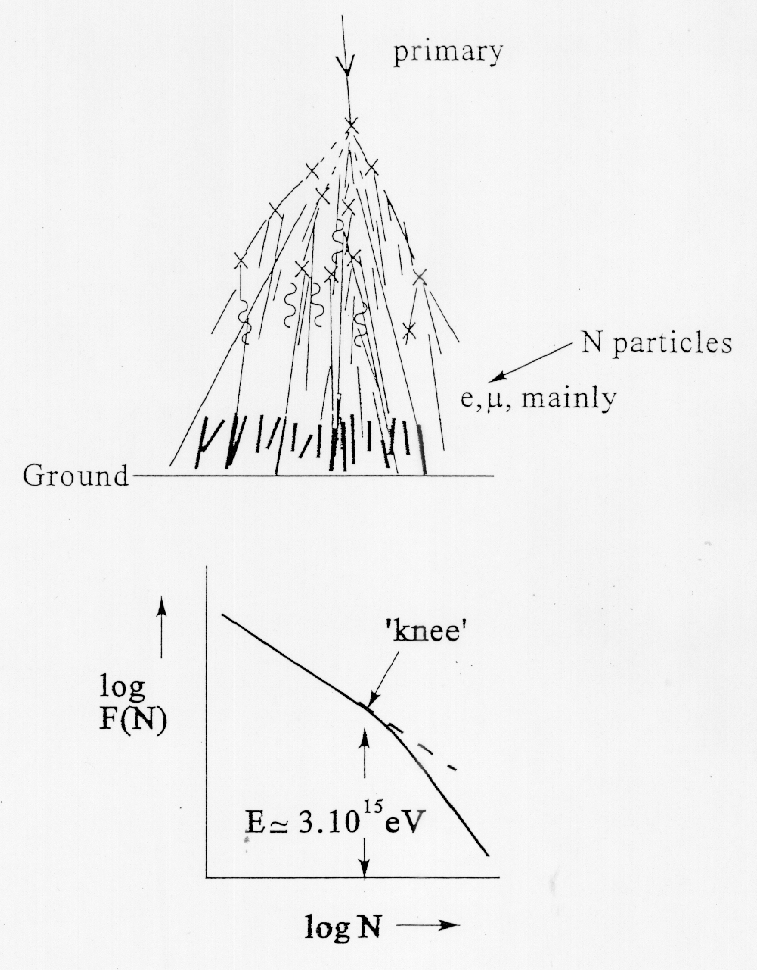
Figure 7
Schematic diagram of an "extensive air shower" and the
corresponding "size-spectrum". N denotes the total number
of particles in the shower at ground level. The knee, discovered
by the Moscow State
University (MSU) group in
1958 [19], is indicated.
One of the main quantities measured in EAS is the so-called size spectrum, F(N), i.e. the frequency with which a shower of size N particles is recorded (N is determined by allowing for those particles which fall between and outside the particle detectors which are spread over the ground).
Figure 7 shows the "size
spectrum" in diagrammatic form. Some forty years ago [20]
a "knee" was discovered, a feature which has persisted
to this day. It has been found time and time again by detection
arrays all over the world. Clearly, the knee is trying to tell
us something about where the particles come from and how they
have been accelerated.
It is this feature that Erlykin and I claim to have explained.
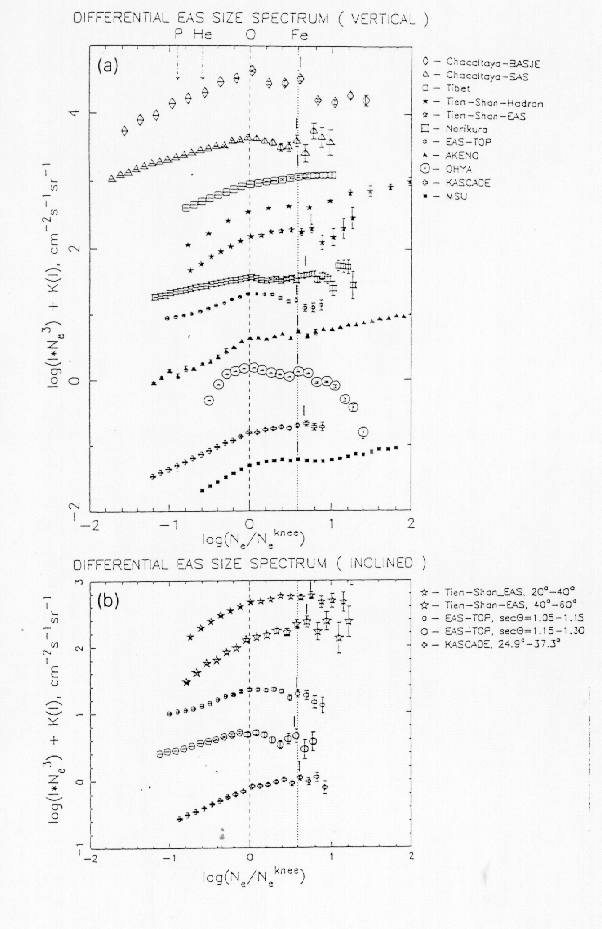
Figure 8
Size spectra from many experiments, standardised to the same
knee position (size = 
 )
[17]. We (Erlykin and Wolfendale) claim to have identified a small
"peak" at an abscissa of + 0.6. We associate the knee
with oxygen nuclei and the second "peak" with iron nuclei.
)
[17]. We (Erlykin and Wolfendale) claim to have identified a small
"peak" at an abscissa of + 0.6. We associate the knee
with oxygen nuclei and the second "peak" with iron nuclei.
A sample of the world's data on F(N) is given in Figure 8; there is roughly the same amount of information, again, from more recent experiments. All of it, to our way of thinking, shows the same result: a small "peak" in the size spectrum at 0.6 in log N beyond the knee. Our results stand, or fall, on this identification.
It will be noted from the figure that occasionally there is a small displacement from 0.6; we claim to understand the reason for most of them. Essentially, in any one experiment, the peak is not statistically significant but when all are added together it becomes so.
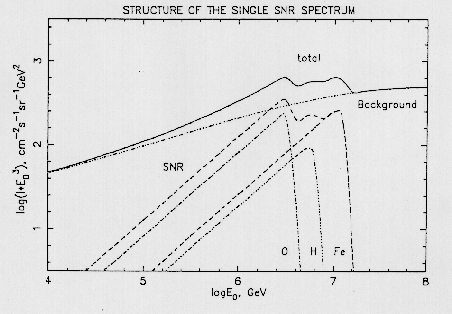
Figure 9
The Erlykin and Wolfendale energy spectra from the hypothesised
local supernova remnant (SNR) [17]. "H" represents "heavy
nuclei" in the range Ne-S.
The EW Interpretation
Figure 9 shows the interpretation, in terms of energies, that the energy spectrum comprises two components, one from a "background" - due to very many, widely distributed, sources in the Galaxy - and the other due to a single, local, recent supernova. This latter should produce the groups of nuclei shown and their spectra should cut off just where we need them if the SN exploded in the local "hot" ISM, for which the equation (equation 1) is valid.
The Cosmic Ray Jigsaw
In a number of recent papers we have examined the extent to which a wide variety of cosmic ray phenomena fit together (Figure 10). We claim that each and every phenomenon is at least not inconsistent with our claim; indeed, some back it very strongly.
Where is the Actual Supernova?
The final question - and it
is one that we have not yet solved - is the actual location of
the claimed supernova.
Although there are several possibilities ("Geminga",
Vela and
perhaps an undetected one in the Loop I region) we have yet to
make a definitive pronouncement.
Time will tell ..
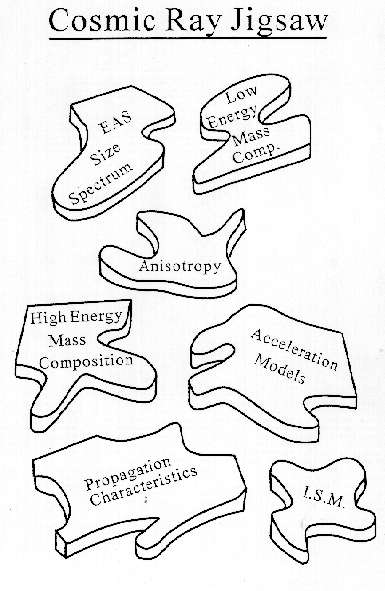
Figure 10
The cosmic ray jig-saw. The Erlykin and Wolfendale model seems
to explain them all and enables them to fit together.
The Future
Not only do we need more data
in the region of the knee in the spectrum but the
source of the "background"
spectrum still needs explaining. Finally, there is the
region above 1018
eV. It is likely that many of the particles below 1019
eV are iron nuclei
produced in our own Galaxy but, at higher energies still, it is
hard to escape the
conclusion that the particles are Extragalactic in origin. Here,
as already mentioned,
the uncertain magnetic field in the Intergalactic Medium causes
problems. The field
should be small enough to allow "local" (say
within 100 million light
years) sources to be identified but none have been, as yet, with
any degree of certainty.
The hunt continues.
References